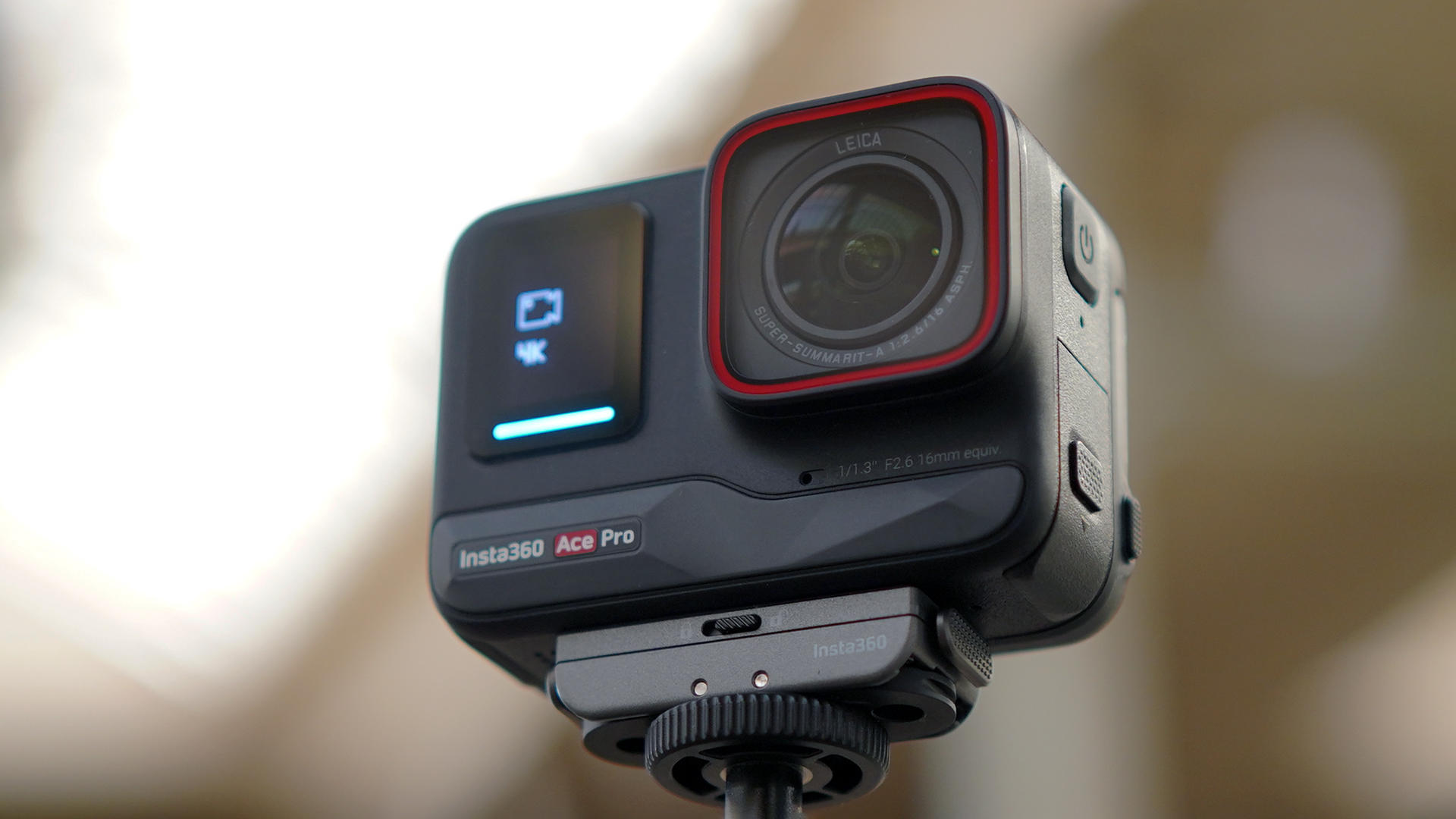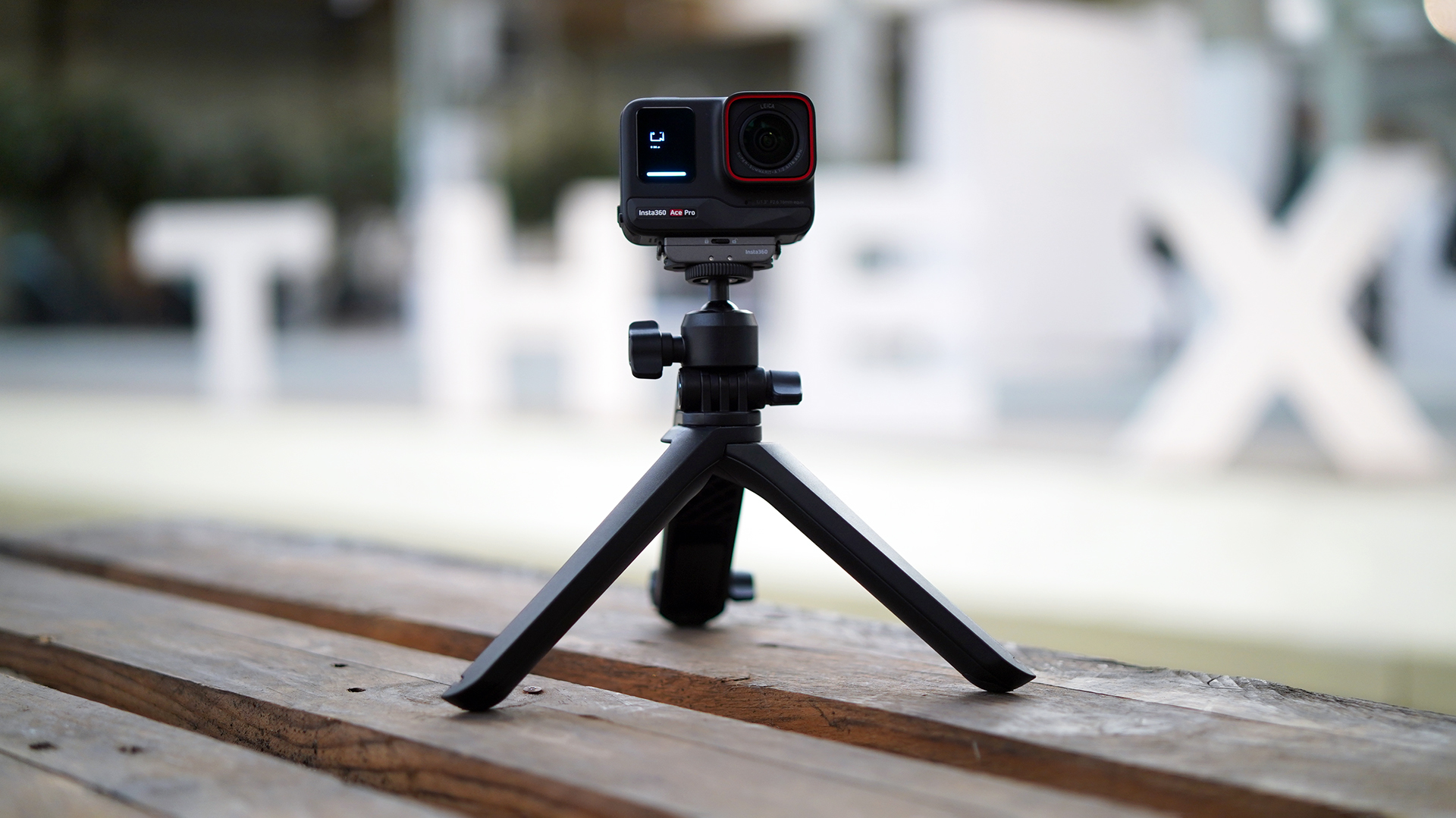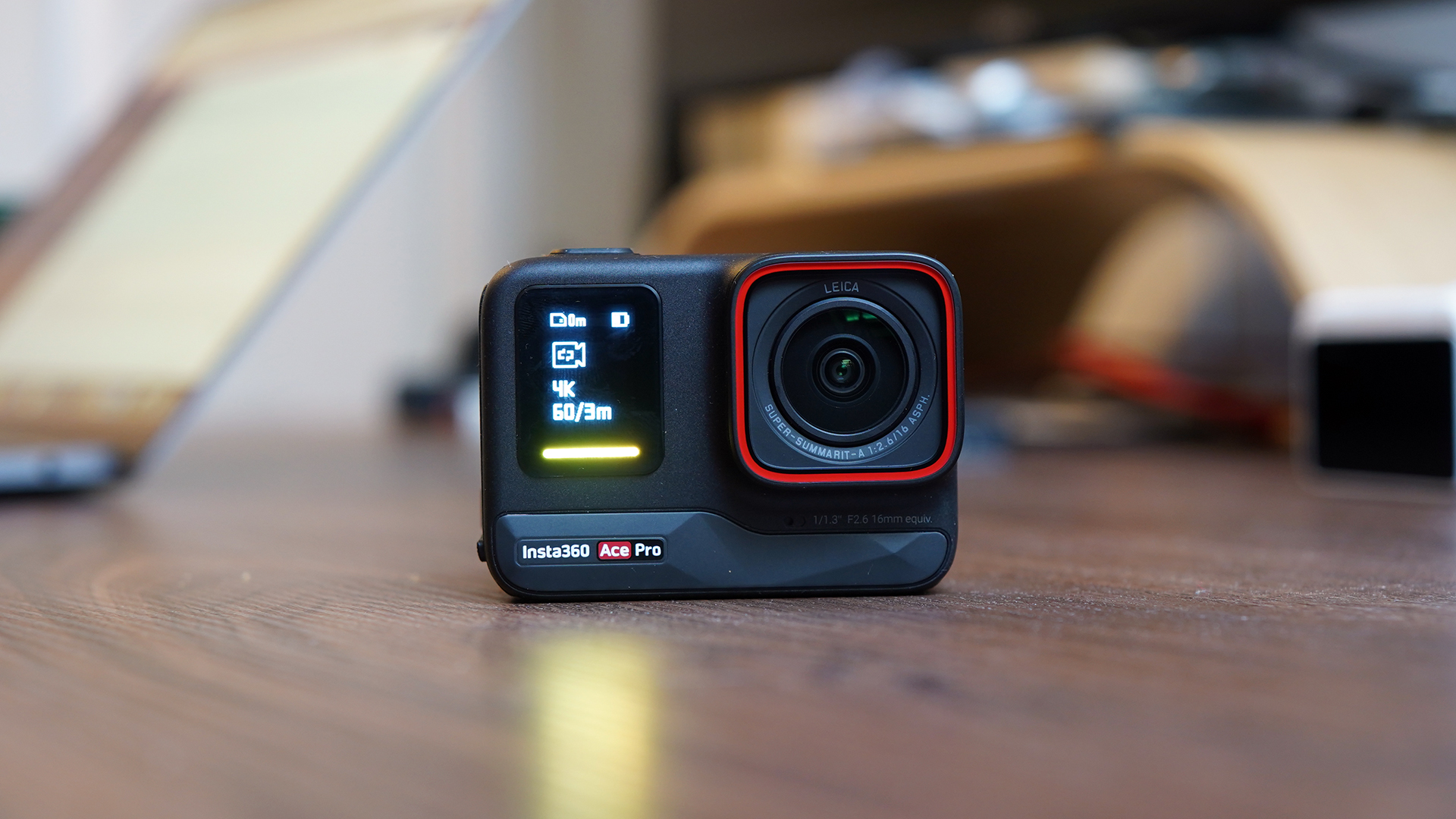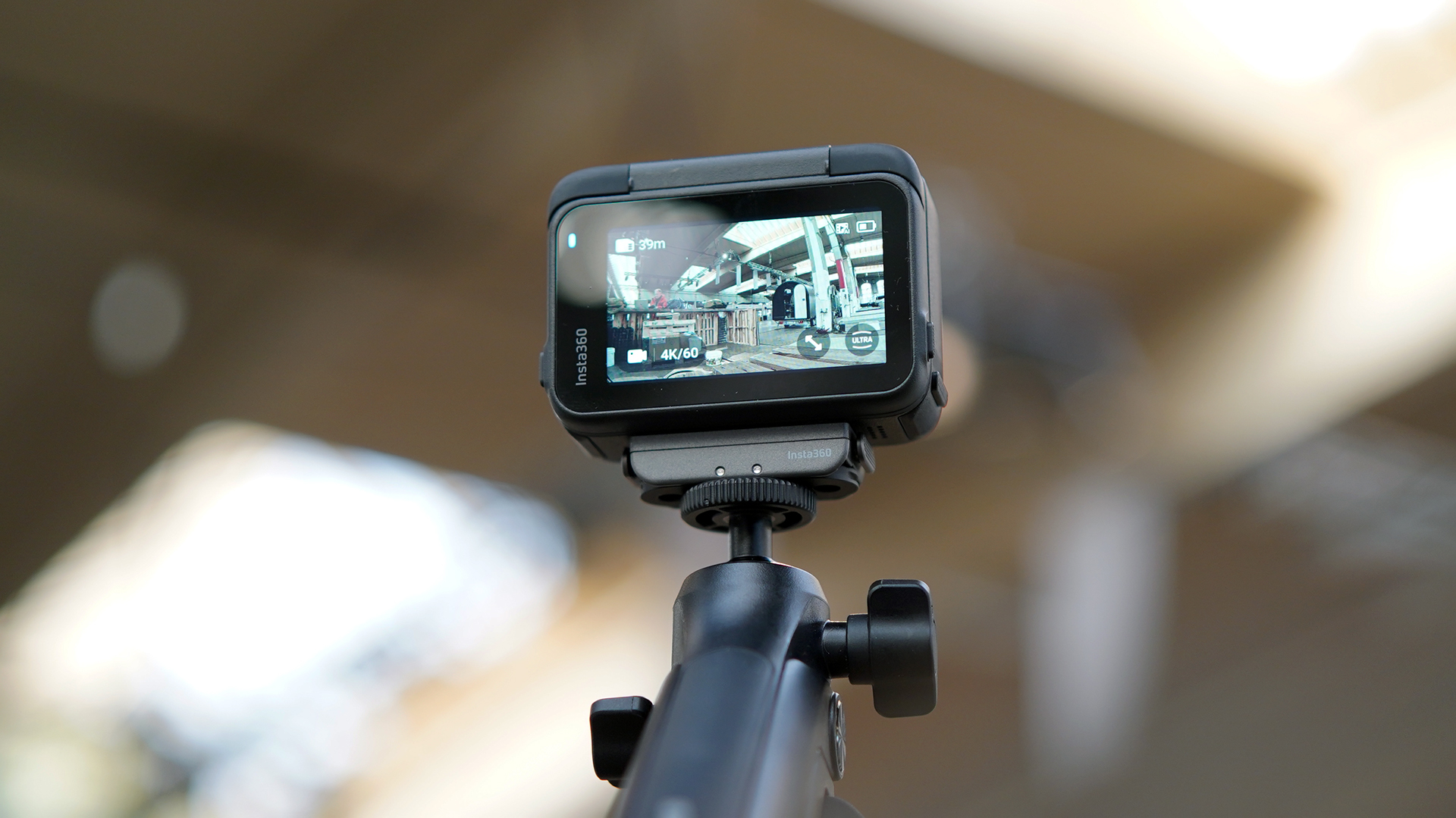Insta360 Ace Pro review: the ultimate, AI-powered rugged vlogging camera
Insta360 is back once again with a unique offering that's right on trend and offers plenty of functionality for vloggers



The Insta360 Ace Pro, co-engineered with Leica, diverge from the brand's signature 360-degree units, resembling traditional action cams like GoPros. Packed with AI-powered features, they offer Leica optics, rugged design, and versatile shooting modes. Ideal for vlogging and outdoor adventures, they excel in low light and offer unique editing options.
-
+
Perfect for vlogging, thanks to the large, pivoting display
-
+
Large sensor for better low-light performance
-
+
A variety of shooting modes, up to 8K and 120 fps (in 4K)
-
+
Lens co-engineered with optics-giant Leica
-
+
Magnetic quick-release attachment is pretty cool
-
-
Vertical shooting requires the camera to be tipped on its side
Why you can trust T3

Co-engineered with Leica, the Insta360 Ace Pro and its smaller sibling, the Insta360 Ace, follow the success of the Insta360 ONE RS 1-Inch, which also used an optical apparatus designed by the legendary German brand. However, the new action cam's shape and functionality resemble the best GoPros, aka traditional action cameras, and is not a 360-degree unit like the RS 1-Inch.
The new model comes at the tail end of a massive year for Insta360. Not only have they won the prestigious T3 Awards in the best action camera category with the Insta360 X3, but they also launched several exciting products, including the Insta360 GO 3, the Insta360 X3 Invisible Dive Case, and the Insta360 Flow AI gimbal.
However, the Ace Pro might be the biggest news from Insta360. Featuring AI-powered features, like AI Highlights and AI Warp, a large sensor, a premium optical unit, and a new chip, the Ace Pro is an exciting new proposition from the brand.
There is a lot to unpack here, so let's dive in to see what you can expect from the Ace Pro and whether you should buy one today.
[First reviewed November 2023]
Insta360 Ace Pro review
Insta360 Ace Pro review: price and availability
The Insta360 Ace Pro was announced on 21 November 2023 and is available to buy now directly from Insta360 for a recommended retail price of $450/ £430/ AU$ 729. Compared to the GoPro Hero 12 Black (RRP $400/ £400/ AU$ 650), the new Insta360 device is more expensive. The Insta360 Ace retails for a bit less and is also available to buy now for a recommended retail price of $379.99/ £359.99/ AU$ 609.
Insta360 Ace Pro review: specifications

| Header Cell - Column 0 | Insta360 Ace Pro | Insta360 Ace |
|---|---|---|
| Sensor size | 1/1.3" | 1/2" |
| Max aperture | F2.6 | F2.4 |
| Max video resolution | 8K (16:9) : 7680x4320@24fps, 4K(16:9): 3840x2160@120 | 6K (16:9) : 6144x3456@30, 4K (16:9) : 3840x2160@120 |
| Max photo resolution | 48MP (8064x6048) | 48MP (8000x6000) |
| Video modes | Video (with built-in Active HDR), FreeFrame Video, PureVideo, Slow Motion, Starlapse, Timelapse, TimeShift, Pre-Recording, Loop Recording | Video, FreeFrame Video, Active HDR , PureVideo, Slow Motion, Starlapse, Timelapse, TimeShift, Pre-Recording, Loop Recording |
| Photo modes | Photo, HDR Photo, Interval, Burst Photo, Starlapse | Photo, HDR Photo, Interval, Burst Photo, Starlapse |
| Weight | 179.8g | 176.8g |
| Dimensions | 71.9mmx52.15mmx38.5mm | 71.9mmx52.15mmx38.5mm |
| Battery capacity | 1650mAh | 1700mAh |
| Charge time | 46min (30W fast charging adapter) 63min: 5V/3A | 70min: 5V/3A |
| Run time | 100 minutes | 100 minutes |
| Connecticity | WiFi, Bluetooth 5.2, USB-C | WiFi, Bluetooth 5.2, USB-C |
Insta360 Ace Pro review: design and build quality

The Insta360 Ace Pro looks distinctively like an action camera. It has a rectangular body with a somewhat protruding optical element, a couple of physical buttons, a large screen at the back and a smaller one at the front of the unit.
Get all the latest news, reviews, deals and buying guides on gorgeous tech, home and active products from the T3 experts
Being a rugged action camera, the Insta360 Ace Pro can handle depths of up to 33 feet (10 meters) and up to 196 feet (60 meters) with the Dive Case, the latter of which is an optional extra. Furthermore, the camera can operate in temperatures as low as -20 °C (—4°F), making it an ideal companion for winter sports.
Apparently, you can potentially boil the Ace Pro without an issue, although I wouldn't recommend trying this trick at home:
A post shared by Christoph Benfey (@cbenfey)
A photo posted by on
Of course, this description only scratches the surface. For example, that protruding optical unit was co-engineered with Leica and boasts 'superior' imaging performance. The unit incorporates a large 1/1.3" sensor, a 5nm AI chip, and a Leica SUMMARIT lens, ensuring excellent low-light capabilities.
The smaller display at the front only shows basic stats, including battery status, memory card info, and the camera's shooting mode, leaving the lion's share of work to the rear screen.

The pivoting 2.4" touchscreen display has a resolution of 240 x 400 pixels and a maximum brightness of 850 nits. It's bright and responsive – no complaints there! The hinged approach ensures you can see the screen from the rear, looking down or facing the camera.
We saw a similar approach in the Insta360 GO 3, which sported a rectangular casing with a pivoting screen. It worked there, and seemingly, it works here, too. Initially, I was concerned about the longevity of the camera's hinged display, but Insta360 released a ton of videos since the launch proving the durability of the camera.
My favourite video literally cooked the camera in hot water (see above), but the poor camera has also been subjected to other brutal tests, as shown below:
Another thing I wanted to mention is the fabulous magnetic mounting system that lets you quickly attach the camera to whatever accessory you decide to use with your Ace Pro. The design is similar to DJI's (see also: DJI Osmo Action 4 review), and apart from the ever-so-slight wobble on the mount – which could be down to me testing a pre-production unit – it works flawlessly.
Insta360 Ace Pro review: features

The Insta360 Ace Pro has numerous shooting modes, resolutions, and framerates to play with. You get the standard video mode up to 8K resolution with built-in Active HDR for videos up to 4K@30fps, FreeFrame Video (which applies image stabilisation, horizon lock and adjustable aspect ratio in post-production), Slow Motion, Starlapse, Timelapse, TimeShift, Pre-Recording, and Loop Recording.
The standout new feature is PureVideo, powered by a 5nm AI chip. It uses a 'custom-trained' AI neural network to denoise the footage in real-time, resulting in a clearer image. This feature is impressive, especially because it enhances the Ace Pro's already excellent low-light performance, thanks to the large sensor and pristine Leica lens.

Photo modes include standard photo (up to 48MP), HDR Photo (shoots multiple images for a high-dynamic-range composite), Interval, Burst Photo, and Starlapse, the latter of which shoots multiple photos and automatically combines them into one single starlapse image.
One of my favourite new features is Clarity Zoom. In certain shooting modes (e.g., standard video mode with a 16:9 image ratio in 4K@60fps), double-tapping the display allows the camera to zoom in and out without any loss of quality. 'How is this even possible?' you might ask.
Well, the Insta360 Ace Pro's max resolution is 8K, which means that when shooting in 4K, some of that maximum resolution is lost, so to speak. When you double-tap, all the camera does is zoom in to that middle 4K frame of the camera without losing resolution. Clever!
There is also Gesture Control, which allows you to use hand signals to start/stop recording or take a photo. You can also pause and record again to keep everything you want to film in one continuous file for easier file management and editing.
Insta360 Ace Pro review: performance
I was sent the review sample of the Insta360 Ace Pro approximately two weeks before the launch date. If you've tried action cams before, you know two weeks isn't enough time to thoroughly test all features, so what you'll find below are my initial thoughts on the device's performance, as opposed to a final summation.
That said, I managed to spend some quality time with the Ace Pro, and what I've seen so far is pretty impressive. I'm a big fan of both the best GoPros and Insta360's user interface, and the Ace Pro combines everything I love about both into an attractive action camera package.
When I say action camera, I mean compact, rugged recording device. More and more people use action cams not just for extreme sports but also for vlogging. Top action cams have high resolution (and framerate) and image stabilisation, are easy to operate and sink into your pocket once you finish recording. They can also connect to wireless Bluetooth microphones or earbuds, which enhances audio performance when used for vlogging.
Insta360 knows this, which is why I feel the Ace Pro is more of a vlogging camera than an action camera. It's pretty rugged, don't get me wrong, but equally, it's almost tailor-made for shooting videos where you stare at the camera, thanks to that large pivoting screen.
The Ace Pro has most of the cool features that make Insta360 cameras so fun to use, including the different shooting modes and the AI-powered templates and editing modes in the Insta360 app. Some of these are more novelty stuff, admittedly, like the new AI Warp, which uses machine learning to create little 4-second clips of your videos based on your input.
It's fun and easy enough to use, but I found that even if I edit my videos down to the required length (under 15 seconds), the AI Warp feature doesn't consider that and assumes I'd like to add the full video. More established AI-powered features work well, and I expect AI Warp to function properly once it's out of beta.
Video performance and image stabilisation are on point, and audio capturing is also very decent for an action camera. Vertical shooting is available, but you physically have to turn the camera on its side for it to shoot in this mode.
This is all fine and good, but it would be better if you could choose this mode in the camera without making any physical changes. It's possible that, in certain scenarios, you won't be able to shoot in this mode, which is sad.
On one occasion, I wore the Ace Pro mounted on the GoPro Chesty and let it run as long as it could (4K@60fps) for around 40 mins, at which point the memory card ran out of space, to see if the cam overheated. Not only did it not overheat, but it almost felt cool! I was well impressed with the battery performance.
One thing that might compromise this is the AI Highlights feature, which analyses footage on camera and picks out the best bits. In my experience, this feature not only eats up battery life but also struggles slightly with finding the best moments in the videos. I expect it to do a much better job after being refined.
Insta360 Ace Pro review: verdict

It's almost impossible not to like the Insta360 Ace Pro. It has all the ingredients of the best action cameras: premium optics, a large sensor, a variety of shooting modes, easy operation, and a game-changing display. Better still, it offers loads of unique editing options via the Insta360 smartphone app and the Insta360 Studio desktop app.
Although most people will probably compare the Ace Pro with its biggest rival, the GoPro Hero 12 Black, I think the two complement each other. The Hero 12 Black should still be considered the top choice for extreme sports and action shots.
On the other hand, the Insta360 Ace Pro is a better option for the ever-increasing army of bloggers and various content creators. Thanks to the larger sensor and refined algorithm, it is also highly effective in low light.
The Ace Pro is a superb, rugged camera that fits in your pocket and can help create stunning, high-resolution videos and photos on the spot. Highly recommended!
Insta360 Ace Pro review: also consider
An excellent alternative to the Ace Pro would be the Insta360's One RS. The flexible modular design is loads of fun, and the 4K boost lens delivers excellent video quality alongside the existing 360 lens module. It's a well-rounded action camera package that delivers on all fronts. Read Mark's full Insta360 One RS Twin Edition review.
GoPro's last-gen action cam, the Hero 11 Black, is in many ways the ultimate in incremental evolution. It’s a better camera than the GoPro Hero 10 Black in several areas, especially with its brilliantly boosted colour palette and improved user options, but it's almost identical in most of the other ways you can measure. And these days, it's much cheaper than the Insta360 Ace Pro. Read our GoPro Hero 11 Black review, also from Mark.

Matt Kollat is a journalist and content creator who works for T3.com and its magazine counterpart as an Active Editor. His areas of expertise include wearables, drones, fitness equipment, nutrition and outdoor gear. He joined T3 in 2019. His byline appears in several publications, including Techradar and Fit&Well, and more. Matt also collaborated with other content creators (e.g. Garage Gym Reviews) and judged many awards, such as the European Specialist Sports Nutrition Alliance's ESSNawards. When he isn't working out, running or cycling, you'll find him roaming the countryside and trying out new podcasting and content creation equipment.


